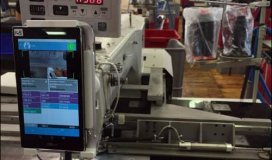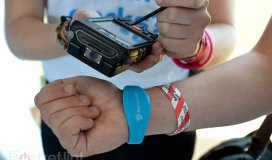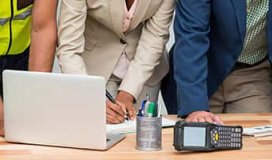Atlanta-based car dealer technology firm MyDealerLot (MDL) has launched a new solution for dealership service and sales that incorporates Bluetooth Low Energy (BLE) beacons, as well as license plate recognition (LPR) technology and drones. Several dealerships are currently trialing the system, known as Bloodhound, though the drone-based option will not be made commercially available until early 2017.
Bloodhound is intended to be a low-cost alternative to the zonal vehicle-tracking RFID system that MDL has been offering for the past four years, using passive ultrahigh-frequency (UHF) RFID tags to monitor vehicles. With the Bloodhound system, dealerships attach reusable Bluetooth beacons (instead of passive RFID tags) in order to record those vehicles' locations and movements by means of smartphones or tablets that workers carry around the lot. The drone option will allow for automated updating of location information, coupled with a video of the drone's flight over the dealer's inventory.
MDL has tested the drones at its headquarters, and plans to carry out additional testing at potential customers' sites. Each drone will come with mounting hardware for attaching a Wi-Fi-enabled mobile computing device that can receive the beacons' transmissions. MDL preconfigures the drone flight plan based on a particular dealer's physical layout, using Google Earth imaging. The read data is then transmitted to the hosted Bloodhound software via a Wi-Fi or 4G connection.
A number of dealerships have already been using MDL's RFID system to identify the specific zones in which cars and trucks are located, based on tag reads as those vehicles move through portals (see Lexus Partners With MyDealerLot to Implement RFID-enabled Customer-Service Solutions). Dealers are also utilizing MDL's Service Drive Concierge, an automatic guest-recognition solution in which passive UHF RFID tags on cars and readers at gates can be used to automatically identify a vehicle—and thus the customer who owns it—as it arrives for servicing. The solution identifies and welcomes that individual by name via a large, flat screen in the service lane. The RFID readers deployed around the service area and at the gate help dealerships to manage the servicing process, the loaning of vehicles to customers and the alerting of those customers when their service is nearing completion so that they can collect their cars, based on the tag reads near the exit gate, explains George Cresto, MyDealerLot's founder and CEO.
Now with Bloodhound, MDL can offer multiple solutions that cost less and are easier to install than the passive RFID version. "The big difference over RFID is that Bloodhound has no major infrastructure to install, no cabling, no readers," Cresto explains. The BLE functionality makes Bloodhound a three-ingredient solution: a removable beacon attached to each car, several larger reference beacons permanently mounted on walls and a mobile app that runs on employees' smartphones or on airborne drones. Users can access the cloud-based Bloodhound software via the internet, using a desktop computer, tablet PC or smartphone. With the Bloodhound system, car dealerships can track both new vehicles on the sales lot and customer-owned cars being serviced on the premises, as well as vehicles loaned to customers while theirs are being serviced.
Each vehicle is fitted with a Bloodhound beacon (a third-party manufacturer custom-makes the beacons for MDL) that can be tethered to the rearview mirror. The beacon emits a unique identifier every second. The beacon's ID number is linked to the car's details, such as its make, model and vehicle identification number (VIN), via MDL's integration with the Dealer Management System (DMS) software.
Vehicles available for sale are parked in the lot or showroom. Throughout the yard or parking area, reference beacons (which are also MDL products made by a third-party manufacturer) are installed on walls, ceilings or light poles. A reference beacon typically covers a 75-square-foot area, with an average ratio of one reference beacon for every five to 10 cars, depending on a lot's layout. Each reference beacon transmits a unique ID that is linked to that beacon's location in cloud-based software. As sales representatives or other individuals walk around the yard, the Bloodhound app installed on their Android or iOS device collects the IDs transmitted by the vehicle and reference beacons. The app then forwards that data to the cloud-based software, which calculates each vehicle's location, based on the reference beacon transmissions received by the drone.
As long as those moving the cars use the mobile app, that data is updated on a continual basis. In some cases, however, companies prefer to perform daily physical inventory counts to ensure that they know what is in their lot and where it is located—even if personnel may not walk throughout that lot on a regular basis. To accomplish this goal, Cresto says, a dealer could use the MDL drone, which comes with a smartphone-size Wi-Fi-enabled computing device attached to it that begins receiving the beacons' signals once the drone is launched. The device also comes with a camera, he adds, that shoots video of the lot.
More information visit rfidjournal.com


